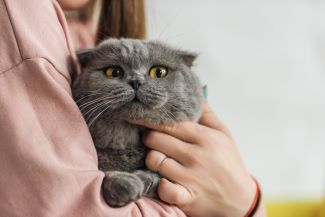Meowing beyond kittenhood is believed to be a language designed for interacting with humans
Cat held by woman

Photo courtesy of Depositphotos
If there is anything that I have come to understand in my short time working in veterinary medicine, it's that cats play by their own rules. They were “domesticated” nearly 10,000 years ago, but their domestication looked a lot different than that of dogs. Sometimes, as I fill my cat's food bowl, scoop his litter, and scoot over in bed to make room for him, I wonder who really domesticated whom. Domestic cats are not nearly as genetically different from their wild counterparts as dogs and wolves are, but they still have distinct behaviors that separate them from their cousins that roam the jungles and savannahs. One of the main differences is one of the first things that you learn about cats as a child: they meow.
Kittens meow to communicate with their mother, but as far as cat-to-cat communication, that's where the meowing stops. Adult cats do not typically meow at each other, and most wild cats do not meow at all. Cats rely on a variety of other vocalizations to communicate with other animals, like roars, yowls, hisses, and growls. Meowing beyond kittenhood is believed to be a language specifically designed for interacting with humans, furthering the idea that maybe cats really did domesticate us rather than the other way around. In fact, one of the most commonly accepted explanations for the development of this special language is based entirely on how we as humans respond to it. Kittens meow to communicate to their mom until she ignores them and they are sent off on their own. However, being the brilliant little creatures that they are, kittens placed in a home with humans will try to use those same sounds that worked with their mom on us. And if we happen to respond to those meows by giving them what they need, which we often do just to get them to stop meowing, then we sign ourselves up for use of that language for the rest of our time together. Essentially, cats teach us their language and we confirm our understanding by giving them what they want, which in turn teaches them to continue meowing at us. It's a vicious cycle, and the cats always seem to come out on top.
This language that we share is an incredibly complex and valuable tool that allows us to better understand our four-legged friends and connect with them in ways that are not possible with most other species. Domestic cats, in particular, have an impressively large vocal repertoire that includes over 21 different vocalizations from chatter, chirps, and growls to hisses, purrs, and trills, all with different meanings unique to the cat and their human. Even more interesting is the variations in pitch and volume that they are capable of achieving within each type of vocalization. If you have a cat at home, you've probably experienced this impressive diversity of sounds every so often, or if you're like me, maybe you get to experience it every single day. My cat, Lou, for instance, has a recognizable meow amongst UC Davis School of Veterinary Medicine students, as each day around 4 p.m. he makes an appearance on my Zoom screen to sing for the class and let them know that it's dinner time.
It's safe to say that many cats meow when they want something, but what's fascinating is the uniqueness of the meows that they are capable of using and the many different meanings they can have. For example, Lou has a distinct meow that I can easily differentiate from other cats when he wants something from me, but when my friends are over he uses a much softer and less demanding meow to beg them for pre-dinner snacks. I have also noticed that if I ignore Lou for long enough, he will try out a new (usually more intense) meow to try to get my attention, as if he wants it known that he is frustrated. I have always known that cats are smart, but I am in awe of just how well Lou has me trained.
It may seem like cats purely communicate with us to get what they want, but that is certainly not true. Think of all of the other adorable and funny sounds that your cat makes throughout the day aside from meowing. Whether they are chirping and trilling after waking up from a cat nap or growling at that pesky feather toy that just won't die, these sounds are what let our cats express themselves and let us understand their personalities. Although incessant meowing may not always be our favorite sound, we are fortunate that our cats choose to develop this language with us, giving us a small glimpse into what they are thinking. This language allows us to deepen our connection across species and strengthen the human-animal bond that has been developing for the last 10,000 years. So whether you have a talker like my Lou or a gentle old purr machine that spends her days sitting quietly on the couch, take some time to get to know their different noises, and be sure to cherish each and every little conversation that they choose to have with you.